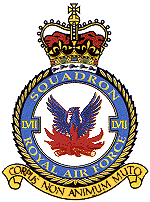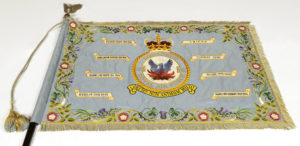
Motto: Corpus non animum muto – “I change my body, not my spirit"
Badge: Issuant from two logs fesse-wise in saltire a phoenix
57 Squadron, Royal Flying Corps, was formed at Copmanthorpe, near York, on 8 June 1916, from a nucleus flight provided by No 33 Home Defence Squadron and in December of the same year crossed to France as a fighter-reconnaissance unit equipped with FE2d aircraft. In May 1917, the Squadron began to convert to Rolls-Royce Eagle-engined DH4s and in June, moved up into the Ypres sector and started long-distance reconnaissance, bombing and photography. In July, oxygen-breathing apparatus and negative-lens bombsights were fitted to all aircraft and thereafter both bombing and photography improved.
57 Squadron met with strong opposition from enemy fighters and suffered many casualties. Indeed, at one stage during this period, the entire aircrew complement of 57 Squadron was killed, wounded or missing in action, but the Squadron continued to fight with new crews. To commemorate this turbulent time in 57 Squadron’s history, a Phoenix rising from the flames of a fire was adopted as 57 Squadron’s emblem, and this symbol of 57 Squadron’s determination was formalised in 1936 in the Squadron’s official crest along with the motto ‘Corpus non animum muto’ – ‘I change my body, not my spirit’.
The Squadron continued photographic reconnaissance and bombing raids on targets behind the enemy's lines, and although it suffered heavy casualties during the summer and autumn of 1918, its record of achievement was high. During its time in France 57 Squadron destroyed 166 enemy aircraft, dropped 285 tons of bombs, exposed 22,030 photographic plates and completed 96 successful reconnaissance runs. 57 Squadron was one of the few non-fighter squadrons of the RFC/RAF to produce flying ‘aces’. Captain William Edward Green scored 9 air-to-air victories, while Captain Arthur Thomas Drinkwater scored 6 victories while flying with 57 Squadron. Following the Armistice on 11 November 1918, 57 Squadron undertook mail-carrying and communications duties across Western Europe using DH9 aircraft, before returning to the UK in August 1919 and being disbanded on 31 December 1919.
On 20 October 1931, 57 Squadron was re-formed at RAF Netheravon as a day-bomber squadron equipped with the famous Hawker Hart, and continued with this type until May 1936 when it re-equipped with the Hawker Hind. The Blenheim came next, and from September 1939 the Squadron operated in the reconnaissance role, at the cost of a number of Squadron crews, before switching to bombing operations from Rosières in France as the Germans invaded the Low Countries in May 1940. In the face of the German advance in 1940, the Squadron was forced to retreat, from Rosières to Poix, and from Poix to Crécy, although even in retreat it took every opportunity to hit back.
On 19/20 May 1940, the Squadron returned to England and on 21 May 1940 reassembled at RAF Wyton. In June 1940 it moved to Northern Scotland and from July to October 1940 - after having first made an attack on enemy-occupied Norway - was employed on anti-shipping sweeps over the North Sea. It then moved south again (to RAF Feltwell), converted to Wellingtons and in January 1941 joined the strategic night-bombing offensive.
In September 1942 the Squadron moved to RAF Scampton, and its Wellingtons were replaced by Lancasters. In the following month ten 57 Squadron aircraft took part in the historic low-level dusk raid on the Schneider works at Le Creusot. In November 1942, 57 Squadron was visited by HM King George VI, this honour being followed, in 1943, by a further Royal visit - this time by both the King and Queen. August 1943 saw 57 Squadron on the move again, this time to RAF East Kirkby, Lincolnshire, where it remained for the rest of WWII.
Among the targets attacked by the squadron in 1944 were the V1 rocket storage sites in the caves at St. Leu d'Esserent, and the Mondeville steelworks at Caen, situated only two thousand yards ahead of the advancing British troops. In December 1944, the Squadron took part in a raid on the German Baltic Fleet at Gdynia, and in March 1945 flew as part of the bomber force which inflicted so much damage to defences around Wesel that advancing Commandos were able to seize the town with only 36 casualties. Of this last attack Field-Marshal Montgomery later said "The bombing of Wesel was a masterpiece, and was a decisive factor in making possible our entry into the town before midnight.".
Disbanded on 25 November 1945, 57 Squadron rose like a phoenix from the ashes the following day when 103 Squadron’s Avro Lincoln Flight was re-numbered as 57 Squadron. In May 1951 the squadron converted to Boeing Washington (B29) aircraft, before entering the jet age in May 1953 when it re-equipped with the English Electric Canberra. The squadron disbanded again on 9 December 1957.
57 Squadron re-formed again on 1 January 1959 at RAF Honington. Equipped with Victor B Mk1 and B Mk 1As it operated in the strategic bomber role as part of the RAF’s V-bomber airborne nuclear deterrent force. December 1965 saw the Squadron on the move again, this time to RAF Marham, which was to be 57 Squadron’s home for the next 21 years. The move to RAF Marham coincided with a change of role for 57 Squadron, continuing to operate the Victor in the air-to-air refueling role. On 30 June 1986, four years after making a vital contribution during the Falklands Conflict, 57 Squadron disbanded again as the RAF’s Victor force was reduced in size.
On 1 June 1992, 57 Squadron reformed at RAF Lyneham, operating the C-130K Hercules. Later, in 1999, 57 Squadron undertook the preparatory work for the introduction into RAF service of the C-130J Hercules, before the Squadron was disbanded again on 14 March 2002.
Once again rising from the ashes, 57 Squadron reformed on 1 October 2008 at RAF Wyton, flying the Grob Tutor aircraft in the RAF’s elementary flying training role. As part of a consolidation of elementary flying training, the Squadron relocated to RAF College Cranwell in September 2014. From late 2017, the Squadron began operating the Grob 120TP Prefect aircraft, provided under the UK's Military Flying Training System.
Battle Honours
